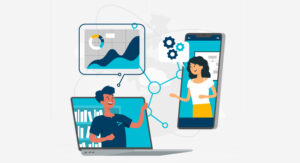Steps to Improve Customer Onboarding Experience During Sign Up

Since the pandemic, our lives have switched online. Online work, online classes, online lectures and seminars and even visiting the doctor online. The way online technology has evolved and changed our lives, there’s no going back to the old and traditional methods. The proper digital onboarding process can improve customer onboarding experience.
In many situations, companies have to verify if the people are who they claim to be. But this has reduced the overall customer onboarding experience. There are other elements that reduce the customer experience are “Two-Factor Authentication, One-Time Passwords, Text Codes, Email Codes, and Time-Sensitive Codes”. None of these elements offer a great customer experience. However, firms need to verify their customers, recognizing customers in the initial step of the business relationship is always a good thing.
According to a recent report, 57% of users claimed that ‘ease of accessing their accounts’ is more important than “understanding customer interests”.
Customer Experience and Identity Verification
When you verify customer identities, you need to understand that verification is the initial step of the business relationship. Most of the time, proving customer identities isn’t the sole purpose of a customer. Rather, it’s an obligation that they have to follow to finally access the services. Customers can access services like sending money online, book an appointment, or online financial services.
So instead of creating an extra burden on the customers, you can focus on how you can make the verification process better, for both you and the customers. Firms can follow some steps to keep the security intact all the while improving the customer experience.
Steps to Improve Customer Onboarding Experience
1. Fewer Clicks Doesn’t Mean Better User Experience
Onboarding is an important part of the overall customer experience. The main goal is to keep the people engaged, improve the conversion rate and reduce the drop-off rate. Adding ID verification to the customer onboarding adds a new step and to reduce friction it can be tempting to shorten the process by reducing the number of clicks.
But identity verification is a huge step, and it’s crucial that people understand why they have to go through the process. To also ensure that process is explained clearly, you need to offer guidance so that people just have to do it once.
So instead of reducing the number of clicks, your aim should be a focus on being as helpful as possible. Explain to the customers the why and the how of the ID verification. Having a small and to-the-point guide can help you increase the customer onboarding experience.
2. Get Smart About Waiting Times
It’s vital for businesses to quickly complete the verification process. Having to wait even 5 seconds can feel like hours when you’re in front of a screen. In a world that’s going fully digital, customers hate to wait for long periods. Your customers need to know how much they’ve progressed in the process.
Provide your customers with something to do, so they’re actively waiting, such as allowing customers to explore the app or to do something while the process goes on in the background. And if that’s not possible, let them know how much time it’ll take for the process to get completed.
3. Get Users at the Right Time
In some specific industries such as financial services, the ID verification process is required by law. Businesses have to fulfill KYC regulations and take important steps to verify customer data. Although, adding identity verification in the framework can make all the difference in the world.
The ID verification process needs to be in the right part of the whole onboarding process.
4. Sometimes, Friction Can be Good
While identity verification creates an additional step in your flow, and usually people say that additional steps create friction. But friction sometimes has some benefits. You can add a biometric verification process that does add a new step yet verifies customer data quickly, securely, and efficiently. Businesses just need to use the friction to their advantage.
5. Customer ID Verification Adds Value
This step applies to industries where the user won’t initially expect to do identity verification. Industries like retail, sharing marketplaces, and gaming don’t usually rely on identity verification. But sometimes additional steps increase trust and brand value. Although, you’d have to let your customers know why and how it benefits them.
Features like “Autofill data” are simple and they improve the customer onboarding experience. For biometric verification, they can just click a photo of themselves. One of the biggest advantages of the customer verification process is that they can use their biometrics to access their accounts if the customers are locked out.
6. Don’t Forget About Things that Can Go Wrong
Things can go wrong all the time with customers while trying to sign up for new services. What do you think happens to the customers who aren’t able to go through the sign-up process, or those who fail the ID verification check?
Fortunately, this happens to just a small number of customers. However, that often means the experience for these customers is deprioritized. People who are locked out of their accounts and can’t access online services have to:
- Going to the ATM for getting money withdrawn
- Withdraw a random amount of money
- Then deposit the money to the bank
- Get in touch with the bank by getting through exhausting customer services
This multi-level process is an experienced killer. Businesses only want people to go through our ID verification flow just once. If customers fail to do the customer verification check, businesses need to check why that happens?
7. Common Process for Everyone
Conclusively, every type of customer should have access to the products and services they want. That’s why it is important to make ID verification accessible to every kind of customer.
The purpose of designing is to improve the usability and usefulness of digital services. Products that are designed with general accessibility in mind are extremely beneficial for everyone. Plus, making sure all kinds of customers can access your services is a great incentive for building the services.













